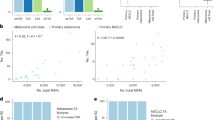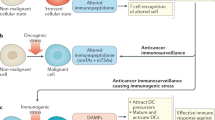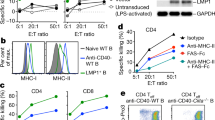Abstract
NY-ESO-1 gene encodes a novel member of the cancer/testis (CT) family of human tumour-associated antigens (TAA). Specific monoclonal antibodies (mAb) have identified the corresponding gene product in lysates of tumour cell lines as a 22 kDa protein but no data are available concerning its intracellular location or distribution within neoplastic tissues. We have generated NY-ESO-1 specific mAbs recognizing the target molecule in cytospin preparations and in sections from clinical tumour specimens. These reagents identify NY-ESO-1 TAA in melanoma cell lines expressing the specific gene as a cytoplasmic protein, sharing the intracellular location of most MAGE TAA. In a series of 12 melanoma specimens, specific staining, limited to neoplastic cells, was detectable in the five cases where NY-ESO-1 gene expression was observed. In two of them over 90% of tumour cells showed evidence of positive staining. Lower percentages of positive neoplastic cells ranging between single cells and 50% were observed in the remaining tumours. These data suggest that active specific immunotherapies targeting NY-ESO-1, alone or in combination with other TAA could be of high clinical relevance in sizeable subgroups of melanoma patients. © 2000 Cancer Research Campaign
Similar content being viewed by others
Article PDF
Change history
16 November 2011
This paper was modified 12 months after initial publication to switch to Creative Commons licence terms, as noted at publication
References
Boon T and van der Bruggen P (1996) Human tumor antigens recognized by T lymphocytes. J Exp Med 183: 725–729
Carrel S, Schreyer M, Spagnoli G, Cerottini J-C and Rimoldi D (1996) Monoclonal antibodies against recombinant-MAGE-1 protein identify a cross-reacting 72-kDa antigen which is co-expressed with MAGE-1 protein in melanoma cells. Int J Cancer 67: 417–422
Chaux P, Vantomme V, Stroobant V, Thielemans K, Corthals J, Luiten R, Eggermont AM, Boon T and van der Bruggen P (2000) Identification of MAGE-3 epitopes presented by HLA-DR molecules to CD4(+) T lymphocytes. J Exp Med 189: 767–778
Chen Y-T, Stockert E, Chen Y, Garin-Chesa P, Rettig WJ, van der Bruggen P, Boon T and Old LJ (1994) Identification of the MAGE-1 gene product by monoclonal and polyclonal antibodies. Proc Natl Acad Sci USA 91: 1004–1008
Chen Y-T, Scanlan MJ, Sahin U, Türeci O, Gure AO, Tsang S, Williamson B, Stockert E, Pfreundschuh M and Old LJ (1997) A testicular antigen aberrantly expressed in human cancers detected by autologous antibody screening. Proc Natl Acad Sci USA 94: 1914–1918
Chen Y-T, Güre AO, Tsang S, Stockert E, Jäger E, Knuth A and Old LJ (1998) Identification of multiple cancer/testis antigens by allogenic antibody screening of a melanoma cell line library. Proc Natl Acad Sci USA 95: 6919–6923
Gudat F, Zuber M, Dürmüller U, Kocher T, Schaefer C, Noppen C and Spagnoli GC (1996) The tumour-associated antigen MAGE-1 is detectable in formalin-fixed paraffin section of malignant melanoma. Virchows Arch 429: 77–81
Hofbauer GFL, Schaefer C, Noppen C, Böni R, Kamarashev J, Nestle FO, Spagnoli GC and Dummer R (1997) MAGE-3 immunoreactivity in formalin-fixed, paraffin embedded primary and metastatic melanoma: frequency and distribution. Am J Pathol 151: 1549–1553
Jäger E, Chen Y-T, Drijfhout JW, Karbach J, Ringhoffer M, Jäger D, Arand M, Wada H, Noguchi Y, Stockert E, Old LJ and Knuth A (1998) Simultaneous humoral and cellular immune response against cancer-testis antigen NY-ESO-1: definition of human Histocompatibility Leukocyte Antigen (HLA)-A2-binding epitopes. J Exp Med 187: 265–270
Jurk M, Kremmer E, Schwarz U, Forster R and Winnacker EL (1998) MAGE-11 protein is highly conserved in higher organisms and located predominantly in the nucleus. Int J Cancer 75: 762–766
Kocher T, Schultz-Thater E, Gudat F, Schaefer C, Casorati G, Juretic A, Willimann T, Harder F, Heberer M and Spagnoli GC (1995) Identification and intracellular location of MAGE-3 gene product. Cancer Res 55: 2236–2239
Lethé B, Lucas S, Michaux L, De Smet C, Godelaine D, Serrano A, De Plaen E and Boon T (1998) LAGE-1, a new gene with tumor specificity. Int J Cancer 76: 903–908
Manici S, Sturniolo T, Imro MA, Hammer J, Sinigaglia F, Noppen C, Spagnoli G, Mazzi B, Bellone M, Dellabona P and Protti MP (2000) Melanoma cells present a MAGE-3 epitope to CD4+ cytotoxic T cells in association with histocompatibility leukocyte antigen DR11. J Exp Med 189: 871–876
Marchand M, Weynants P, Rankin E, Arienti F, Belli F, Parmiani G, Cascinelli N, Bourlond A, Vanwijck R, Humblet Y, Canon J-L, Laurent C, Naeyaert J-M, Plagne R, Deramaeker R, Knuth A, Jäger E, Brasseur F, Herman J, Coulie PG and Boon T (1995) Tumor-regression responses in melanoma patients treated with a peptide encoded by gene MAGE-3. Int J Cancer 63: 883–885
Marchand M, van Baren N, Weynants P, Brichard V, Dreno B, Tessier M-H, Rankin E, Parmiani G, Arienti F, Humblet Y, Bourlond A, Vanwijck R, Liénard D, Beauduin M, Dietrich P-Y, Russo V, Kerger J, Masucci G, Jäger E, De Greve J, Atzpodien J, Brasseur F, Coulie PG, van der Bruggen P and Boon T (2000) Tumor regressions observed in patients with metastatic melanoma treated by an antigenic peptide encoded by gene MAGE-3 and presented by HLA-A1. Int J Cancer 80: 219–230
Nestle FO, Alijagic S, Gilliet M, Sun Y, Grabbe S, Dummer R, Burg G and Schadendorf D (2000) Vaccination of melanoma patients with peptide- or tumor lysate-pulsed dendritic cells. Nature Med 4: 328–332
Sahin U, Türeci O, Schmitt H, Cochlovius B, Johannes T, Schmits R, Stenner F, Luo G, Schobert I and Pfreundschuh M (1995) Human neoplasms elicit multiple specific immune responses in the autologous host. Proc Natl Acad Sci USA 92: 11810–11813
Schultz-Thater E, Juretic A, Dellabona P, Lüscher U, Siegrist W, Harder F, Heberer M, Zuber M and Spagnoli GC (1994) MAGE-1 gene product is a cytoplasmic protein. Int J Cancer 59: 435–439
Stockert E, Jäger E, Chen Y-T, Scanlan MJ, Gout I, Karbach J, Arand M, Knuth A and Old LJ (1998) A survey of the humoral immune response of cancer patients to a panel of human tumor antigens. J Exp Med 187: 1349–1354
Thurner B, Haendle I, Röder C, Dieckmann D, Keikavoussi P, Jonuleit H, Bender A, Maczek C, Schreiner D, von den Driesch P, Bröcker EB, Steinman RM, Enk A, Kämpgen E and Schuler G (2000) Vaccination with Mage-3A1 peptide-pulsed mature monocyte-derived dendritic cells expands specific cytotoxic T cells and induces regression of some metastases in advanced stage IV melanoma. J Exp Med 190: 1669–1678
Türeci O, Sahin U, Schobert I, Koslowski M, Schmitt H, Schild HJ, Stenner F, Seitz G, Rammensee HG and Pfreundschuh M (1998) The SSX-2 gene, which is involved in the t(X;18) translocation of synovial sarcomas, codes for the human tumor antigen HOM-MEL-40. Cancer Res 56: 4766–4772
Van Baren N, Brasseur F, Godelaine D, Hames G, Ferrant A, Lehmann F, André M, Ravoet C, Doyen C, Spagnoli GC, Bakkus M, Thielemans K and Boon T (2000) Genes encoding tumor-specific antigens are expressed in human myeloma cells. Blood 94: 1156–1164
Wang RF, Johnston SL, Zeng G, Topalian SL, Schwartzentruber DJ and Rosenberg SA (1998) A breast and melanoma-shared tumor antigen: T cell responses to antigenic peptides translated from different open reading frames. J Immunol 161: 3598–3606
Author information
Authors and Affiliations
Rights and permissions
From twelve months after its original publication, this work is licensed under the Creative Commons Attribution-NonCommercial-Share Alike 3.0 Unported License. To view a copy of this license, visit http://creativecommons.org/licenses/by-nc-sa/3.0/
About this article
Cite this article
Schultz-Thater, E., Noppen, C., Gudat, F. et al. NY-ESO-1 tumour associated antigen is a cytoplasmic protein detectable by specific monoclonal antibodies in cell lines and clinical specimens. Br J Cancer 83, 204–208 (2000). https://doi.org/10.1054/bjoc.2000.1251
Received:
Revised:
Accepted:
Published:
Issue date:
DOI: https://doi.org/10.1054/bjoc.2000.1251
Keywords
This article is cited by
-
Metastatic biomarkers in synovial sarcoma
Biomarker Research (2017)
-
IL-15 augments antitumoral activity of an ErbB2/HER2 cancer vaccine targeted to professional antigen-presenting cells
Cancer Immunology, Immunotherapy (2012)
-
Molecular and immunological evaluation of the expression of cancer/testis gene products in human colorectal cancer
Cancer Immunology, Immunotherapy (2007)
-
Immunohistochemical analysis of the expression of FATE/BJ-HCC-2 antigen in normal and malignant tissues
Laboratory Investigation (2005)
-
Serological cloning of cancer/testis antigens expressed in prostate cancer using cDNA phage surface display
Cancer Immunology, Immunotherapy (2004)



